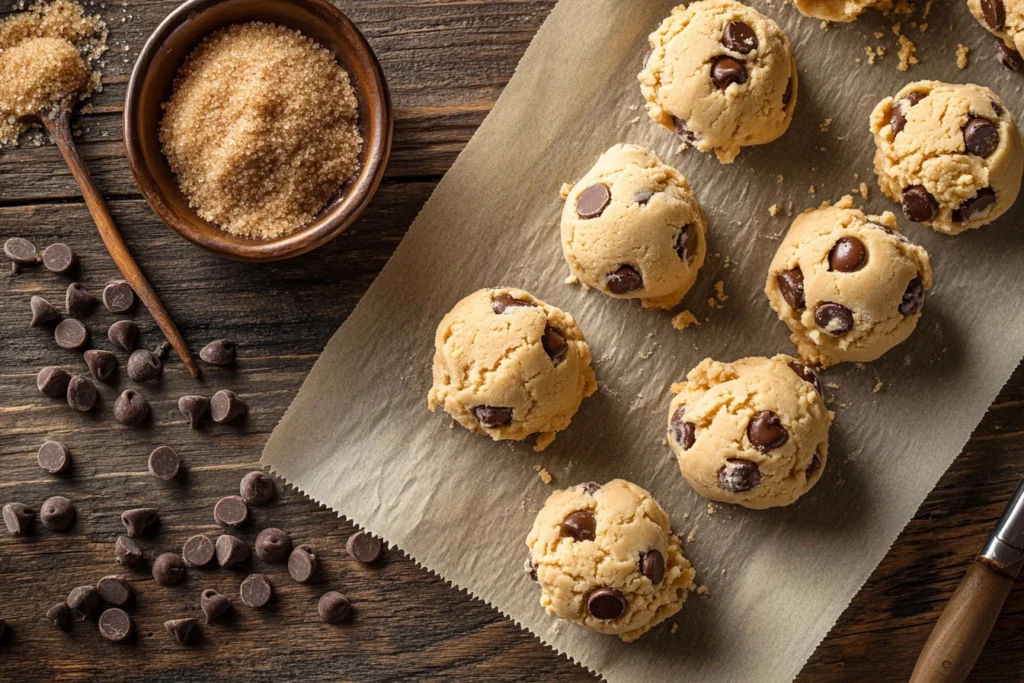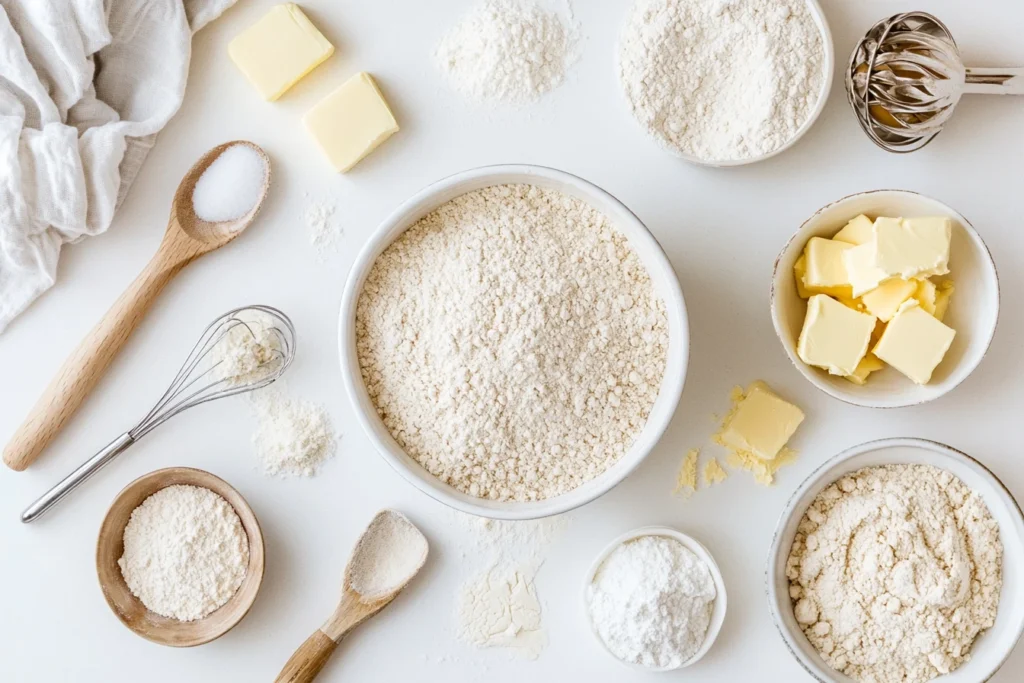Exploring the Ingredients in Nestlé Cookie Dough
Why We Love It—and Why We Need to Know What’s Inside
Whether you’re sneaking a spoonful straight from the fridge or baking a warm batch to share with family, Nestlé cookie dough is a staple in American kitchens. It’s nostalgic, convenient, and undeniably delicious.
But as ingredient awareness and dietary needs become more important, many home bakers and cookie lovers are asking a simple question: What are the ingredients in Nestlé cookie dough? And beyond that—what if you’re gluten-sensitive, avoiding nuts, or curious about customizing it with ingredients like almond flour?
In this article, we’ll break down the core ingredients found in Nestlé’s signature cookie dough, examine allergen considerations, explore gluten-free options, and even guide you on how to personalize your cookies while keeping that classic Toll House taste intact.
Let’s start with what’s actually inside that iconic yellow wrapper.
1. Understanding Nestlé Cookie Dough Ingredients
1.1 Flour and Leavening Agents
At the heart of every batch is bleached wheat flour, the structural base of Nestlé cookie dough. For detailed nutritional information and a full list of ingredients, refer to the official Nestlé Toll House Chocolate Chip Cookie Dough page.
Speaking of leavening, Nestlé uses baking soda (sodium bicarbonate) in its classic chocolate chip recipe. This ingredient helps the dough rise and spread just enough to deliver that chewy center with lightly crisped edges.
For those with gluten sensitivity, it’s important to note that wheat flour is not gluten-free. We’ll explore Nestlé gluten-free cookie dough ingredients later in this article.
1.2 Sweeteners and Fats
Nestlé uses a combination of granulated sugar and brown sugar to build the signature sweetness and caramel-like depth in their cookie dough. Brown sugar, with its molasses content, adds moisture and chewiness—key to that soft, bakery-style texture.
As for fats, the dough traditionally includes butter or margarine. Butter adds rich flavor, while margarine (which Nestlé sometimes uses in refrigerated or frozen formats) helps with shelf stability and consistency across batches.
Together, these ingredients create a dough that browns beautifully, spreads just right, and stays tender without being greasy.
1.3 Chocolate Chips and Additives

Ah, the chocolate—the most famous part. Nestlé’s semi-sweet morsels are made from sugar, chocolate, cocoa butter, milkfat, soy lecithin, and natural flavors. Soy lecithin, an emulsifier, helps the chips keep their shape during baking.
Additional minor ingredients may include:
- Salt: Enhances flavor
- Vanilla extract: Adds aroma and depth
- Preservatives (in some refrigerated products): Extend shelf life
- Color additives (in specialty versions)
All ingredients are listed clearly on the product label, and Nestlé’s corporate site emphasizes their commitment to transparent labeling for allergens and nutrition.
2. Addressing Dietary Concerns
When you’re dealing with food allergies or dietary restrictions, grabbing a package of store-bought cookie dough isn’t always simple. Thankfully, Nestlé is transparent about what goes into their products—but there are still important things to know if you’re avoiding gluten, nuts, or specific allergens.
Let’s break it down.
2.1 Gluten Content in Nestlé Cookie Dough
If you’re following a gluten-free diet, whether for medical reasons or personal wellness, you’ve probably scanned the cookie dough aisle hoping for a gluten-free Nestlé option. So, here’s the scoop:
Traditional Nestlé Toll House cookie dough is not gluten-free.
It contains bleached wheat flour, which means it’s not suitable for anyone with celiac disease or gluten sensitivity.
Unfortunately, as of now, Nestlé does not offer a certified gluten-free version of its refrigerated or ready-to-bake cookie dough products. However, the brand has released several new lines in recent years, including plant-based and allergy-conscious snacks, so it’s worth keeping an eye on updates.
So what are your options?
- DIY route: You can try re-creating Nestlé’s famous recipe at home using 1:1 gluten-free flour blends or almond flour (more on that in Section 3).
- Alternative brands: Other companies, like Sweet Loren’s or Cappello’s, offer certified gluten-free cookie dough options for those with severe gluten sensitivity.
While Nestlé gluten-free cookie dough ingredients aren’t available in an official product (yet), you can easily make a close replica at home using safe substitutes.
Chef Aila’s tip: “Gluten-free flour blends tend to absorb more moisture. Add a splash of milk or an extra egg yolk to keep your dough soft and chewy.”
2.2 Nut Allergies and Cross-Contamination
Now let’s talk about one of the most common food allergy concerns: nuts.
Does Nestlé cookie dough contain nuts?
The classic Nestlé Toll House chocolate chip cookie dough recipe does not contain nuts as a primary ingredient. However, many Nestlé products are manufactured in facilities that also process tree nuts and peanuts, which means there is a risk of cross-contact.
Here’s what Nestlé has to say:
“If any of the eight major allergens are in a product—even in small amounts—they will be listed in the ingredients. If there is a risk of cross-contact, we include a ‘may contain’ statement.”
(Source: Nestlé official allergen policy)
What you should do:
- Always read the packaging carefully before purchasing.
- Look for the “contains” and “may contain” statements below the ingredient list.
- Avoid buying open or repackaged dough from bakery cases if you have a severe allergy.
In addition to chocolate chip dough, Nestlé has produced seasonal and specialty cookie doughs that may include nuts or nut-based flavors, so vigilance is key.
Safe Customization Tip:
If you want to add nuts to your cookies at home (for those who can enjoy them), always use roasted and cooled nuts and fold them in just before baking. Pecans, walnuts, and chopped almonds all work well with Nestlé’s base dough.
Chef Aila’s reminder: “When baking for others, assume someone has a nut allergy unless you know otherwise. It’s always better to ask—or label clearly!”
3. Customizing Nestlé Cookie Dough
Sure, store-bought Nestlé cookie dough is delicious right out of the package—but that doesn’t mean you can’t put your own spin on it. Whether you’re baking for a special diet, craving a new texture, or just feeling creative in the kitchen, customizing pre-made dough is easier than you think.
3.1 Incorporating Alternative Flours
One of the most popular questions from home bakers is: Can I tweak the dough by adding or replacing ingredients like almond flour?
The short answer? Yes, with some strategy.
Using Almond Flour in Nestlé Recipes

Almond flour has a rich, slightly sweet flavor and a finer, softer texture than wheat flour. It’s made from finely ground blanched almonds and is naturally gluten-free, making it a go-to for low-carb and grain-free baking.
But here’s the catch: almond flour behaves differently than regular flour.
Tips for using almond flour with Nestlé dough:
- Partial substitution is best: Replace up to 25% of the wheat flour in a homemade version of Nestlé’s classic recipe with almond flour. If you’re using packaged dough, try kneading in 1–2 tablespoons of almond flour to enrich the texture slightly.
- Expect a softer cookie: Almond flour adds moisture, which may make the cookies more tender and slightly cakey.
- Watch the spread: Cookies may not spread as much with almond flour, so shape your dough balls flatter if needed.
Chef Aila’s note: “Almond flour adds a lovely nutty undertone to the cookies—great with dark chocolate chips or a pinch of sea salt.”
⚠️ Important: If you’re baking for someone with a nut allergy, almond flour is a definite no-go. Stick to gluten-free flour blends instead.
3.2 Adding Mix-Ins and Flavor Enhancements
Customizing Nestlé cookie dough goes way beyond flour swaps. You can transform a basic batch into bakery-worthy treats with just a few creative tweaks. For instance, understanding the differences between various desserts can inspire new creations. Learn more about the distinctions between blondies and brookies in our article on What’s The Difference Between A Blondie And A Brookie?
Delicious mix-in ideas:
- Chopped nuts (walnuts, pecans, macadamias)
- Dried fruit (cranberries, cherries, apricots)
- Spices (cinnamon, nutmeg, espresso powder)
- Extracts (almond, peppermint, or maple for a flavor twist)
- Mini marshmallows or toffee bits for a gooey crunch
Flavor-enhancing tips:
- Add a pinch of flaky sea salt on top of each cookie before baking for contrast.
- Stir in a tablespoon of cream cheese to give the dough a soft, tangy bite.
- Fold in crushed pretzels or potato chips for a salty-sweet combo.
Pro Tip:
Delicious mix-in ideas include chopped nuts (walnuts, pecans, macadamias) and dried fruits (cranberries, cherries, apricots). Incorporating such elements can elevate your cookies to a gourmet level. For a unique twist, explore our Dubai Chocolate Bar Recipe: Luxurious Middle Eastern Dessert, which showcases the use of high-quality ingredients and mix-ins.
Balancing Moisture:
If you’re adding dry ingredients like cocoa powder or extra flour, compensate by mixing in a splash of milk or softened butter to keep the dough soft and bake-ready.
Chef Aila’s creative challenge: “Pick one sweet and one salty mix-in. Combine with Nestlé dough, bake a small test cookie—and taste your new signature blend!”
4. Baking Tips for Optimal Results
You’ve got the dough, maybe even added your own spin—now let’s make sure it bakes up perfectly. Nestlé cookie dough is designed to be easy and foolproof, but a few small tweaks in the kitchen can take your cookies from good to next-level bakery quality.
4.1 Proper Dough Handling and Storage
Refrigerate before baking (even if you don’t have to).
While Nestlé’s refrigerated cookie dough is technically ready to bake straight from the pack, giving it 15–30 minutes in the fridge before baking firms it up slightly and leads to a better texture. Cold dough spreads less, which helps your cookies stay thick and chewy in the center.
Freezing cookie dough? Totally fine.
Nestlé dough freezes well—just shape it into balls and store in an airtight container or zip-top bag for up to 2 months. Bake directly from frozen—just add 1–2 minutes to the bake time.
Leftovers or unbaked dough:
Once opened, store remaining dough in an airtight container in the fridge and use within 5 days. Always check the label for the best-by date if you’re unsure.
4.2 Achieving Desired Cookie Textures

Everyone has their cookie preference: some love chewy centers, others go for crispy edges. Nestlé cookie dough can do both—with just a little finesse.
For chewy cookies:
- Bake for the shorter time range listed on the package (usually 10–11 minutes).
- Let the cookies rest on the sheet for 2–3 minutes before transferring—they’ll finish baking from residual heat.
- Add a tablespoon of brown sugar to the dough for extra moisture and chew.
For crispier cookies:
- Bake on the longer end of the time range (12–13 minutes), and use a slightly higher oven rack.
- Use a darker baking sheet, which absorbs more heat and browns the bottoms faster.
- Flatten dough balls slightly before baking to encourage even spreading.
Pan choice matters:
- Nonstick sheets = crispier edges.
- Parchment paper or silicone mats = softer centers.
Chef Aila’s tip: “Always bake a test cookie first—every oven is different, and a single cookie can save the whole batch.”
5. Frequently Asked Questions (FAQs)
Can I make Nestlé cookie dough without eggs?
Yes, if you’re looking to avoid eggs due to allergies or dietary choices, you can make a homemade version of Nestlé’s classic recipe using egg substitutes. Try:
- Flax egg (1 tbsp ground flaxseed + 3 tbsp water, let sit 5 mins)
- Unsweetened applesauce (¼ cup per egg)
- Mashed banana (¼ cup per egg, adds sweetness)
Keep in mind: the texture may be softer, and the cookies slightly denser.
How can I ensure my cookies stay soft after baking?
To keep Nestlé cookies soft even after they’ve cooled:
- Store them in an airtight container with a slice of bread—the moisture helps maintain chewiness.
- Underbake slightly and allow them to finish setting on the baking sheet.
- Avoid stacking warm cookies; let them cool completely to prevent steaming.
Is it safe to eat raw Nestlé cookie dough?
Only if the packaging specifically says it’s safe to eat raw.
Traditional Nestlé cookie dough contains raw flour and eggs, which can pose a risk of foodborne illness if eaten uncooked. However, Nestlé now offers “Edible Cookie Dough” versions that are heat-treated and safe to snack on straight from the tub—look for the label!
Chef Aila’s rule of thumb: “If it’s not labeled ‘safe to eat raw,’ wait until it’s baked—worth the wait every time.”
6. Final Thoughts: The Dough That Delivers
Whether you stick to the classic or experiment with almond flour, sea salt, or secret mix-ins, Nestlé cookie dough is a deliciously versatile base. Understanding what’s inside—from sweeteners to allergens—gives you the power to enjoy your cookies with confidence, creativity, and maybe even a touch of nostalgia.
So next time someone asks about the ingredients in Nestlé cookie dough, you’ll have the answer—and probably a warm batch to share.
